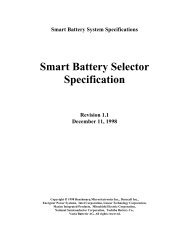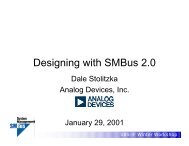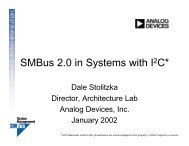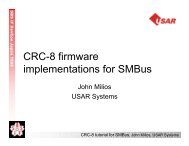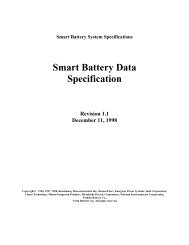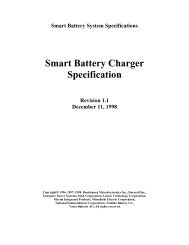Smart Battery System Manager Specification, version 1.0
Smart Battery System Manager Specification, version 1.0
Smart Battery System Manager Specification, version 1.0
Create successful ePaper yourself
Turn your PDF publications into a flip-book with our unique Google optimized e-Paper software.
<strong>Smart</strong> <strong>Battery</strong> <strong>System</strong> <strong>Manager</strong> <strong>Specification</strong>6. Example ImplementationsThis section is intended to provide a closer look at some possible implementations of a <strong>Smart</strong> <strong>Battery</strong><strong>System</strong> <strong>Manager</strong>.6.1. <strong>Battery</strong> Charging TopologiesThere are many possible charging topologies that may be used for simultaneous charging. In the followingsection three are presented. The topology used in any system is selected to meet the cost, safety and usemodels favored by the system designer. The SBSM specification does not have advocate a particulardesign, rather a consistent reporting interface and a safe implementation.6.1.1. Single charger / multiple battery topology #1<strong>Smart</strong> <strong>Battery</strong> <strong>System</strong><strong>Manager</strong><strong>Smart</strong> <strong>Battery</strong>Charger<strong>Smart</strong> <strong>Battery</strong>A<strong>Smart</strong> <strong>Battery</strong>BSMBusPowerFigure 6.1 Single charger / multiple battery topology.Figure 6.1 is a variation of the most common charger topology used by <strong>Smart</strong> <strong>Battery</strong> Selectors today. Inthe case of the selector <strong>version</strong>, the SMBus is switched along with the power. But to charge the batteries inparallel, the SBSM takes on additional responsibilities to ensure system safety. A few of theseconsiderations the SBSM must take before connecting the batteries in parallel to the charger are:The batteries are of the same chemistry. In fact, that they are from the same sub-family within a particularchemistry.The batteries are at the same charge state.The charging current to any individual battery does not exceed its safe limitsIn the simultaneous charging topology shown in Figure 6.1, the SMBuses from each battery are logically“merged” and a composite charging request is sent to the charger. This may be done by the SBSM pollingthe individual battery’s charging current requirements and/or their charging voltage requirements.For example during the early stages of charging lithium batteries, the SBSM will request the charger supplya current value less than or equal to the sum of the currents requested by the individual batteries. TheSBSM will then read the actual current values used by each individual batteries and ensure that noneexceeds the amount that battery requested. As the batteries charge state nears full, the SBSM will transitionSBS Implementers Forum Page 19 Revision <strong>1.0</strong>




